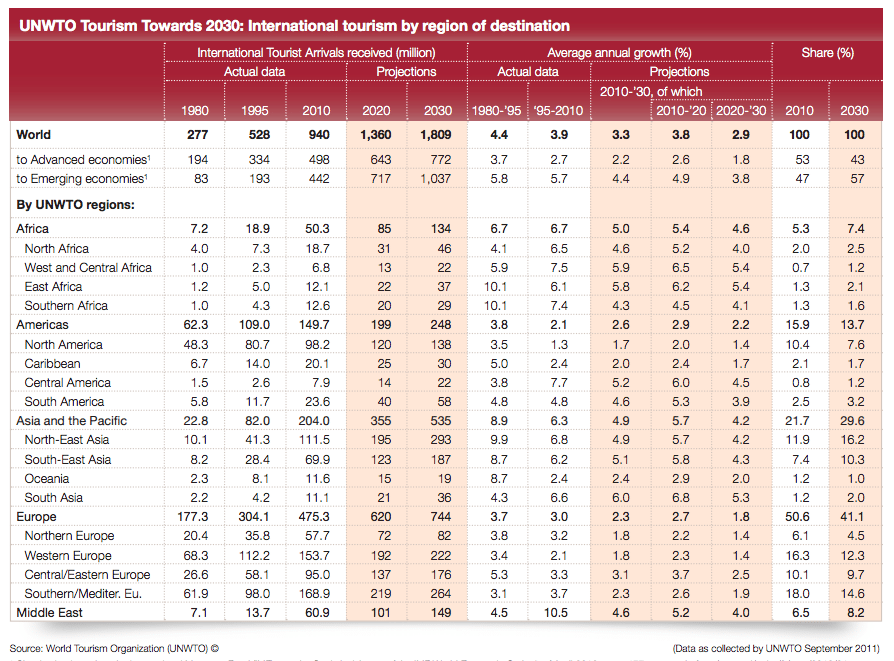Skift Take
The age of Italy as tourist hub is coming to a close, and the world is becoming much more interesting as a result.
More than half of the 1.3 billion annual international arrivals the world can expect by 2020 will travel to destinations with emerging economies, the United Nations World Tourism Organization projects.
Five years from now developing countries in Latin America, Africa, and Asia-Pacific will collectively welcome more international arrivals than developed countries and account for 55% of the market share. By 2030 this number will be about 57% and 1.8 billion international travelers will cross borders.
Europe will still claim the highest number of international visitors in 2020 and 2030 and the largest overall market share (47% in 2020 to 41% in 2030) but adding up the market shares of Latin America, Asia-Pacific, Africa, and the Middle East in 2030 surpasses Europe’s by about 10 percentage points.
The catch: most of these international travelers will visit countries within their own region and about four out of five international arrivals originate from within the same region.
North and South America saw the most year-over-year growth for outbound tourists originating from those regions in 2014 (7.2% combined growth) followed by Asia-Pacific (5.7%), the Middle East (5.2%) and Africa (3.4%).
Here are some other highlights from the organization’s projections:
- International arrivals prospects for 2015 are strongest for Asia-Pacific and the Americas who will both see their arrivals grow by 4% to 5% over 2014, followed by Europe (3% to 4%), the Middle East (2% to 5%) and Africa (3% to 5%).
- In 2014, slightly more than half of all overnight visitors traveled to their destination by air (54%) while the remainder traveled by surface transport (46%) – whether by road (39%), rail (2%) or water (5%). The trend over time has been for air transport to grow at a somewhat faster pace than surface transport and the share of air transport is gradually increasing.
- Leisure travel accounted for a little more than half of all international tourist arrivals (53% or 598 million arrivals) in 2014. Some 14% of international tourists reported traveling for business and professional purposes, and another 27% traveled for other reasons such as visiting friends and relatives, religious reasons and pilgrimages, health treatment, etc. The purpose of visits for the remaining 6% of arrivals isn’t specified.
- Europe saw the largest increase in international tourist receipts year-over-year for 2014: up by $17 billion to reach $509 billion. Asia-Pacific recorded an increase of $16 billion reaching $377 billion and the Americas’ receipts increased by $10 billion to a total of $274 billion.
- China has been the world’s top spender in international tourism since 2012. Chinese travelers spent a record $165 billion abroad in 2014 – an exceptional 27% increase over 2013 ($36 billion more).
- For spending last year, the Middle East was the fastest growing region with a 6% increase in spending receipts, followed by Asia-Pacific and Europe (both up 4%) and the Americas and Africa (both up 3%).
- In the 2014 ranking of arrivals (see report below), Mexico climbed five places, re-entering the top 10 at position 10. In the ranking of tourism spending receipts, China and the U.K. both moved up two places, to positions 3 and 7 respectively. As a result, France and Macao (China) both moved down one place to 4 and 5 respectively, and Thailand moved down two places to 9.
- Europe’s strongest growth came from its northern and southern regions in 2014. Northern Europe’s international arrivals increased 6% year-over-year and Iceland, for example, saw a 24% increase reaching close on 1 million arrivals. Southern Europe saw 7% growth and Greece and Spain each gained 4 million international arrivals last year over 2013. Western Europe’s growth (includes countries like France, Germany and the Netherlands) was only about 2% over 2013 and Central and Eastern Europe’s international arrivals decreased 5%.
See the full report below for more analysis and projections:
The Daily Newsletter
Our daily coverage of the global travel industry. Written by editors and analysts from across Skift’s brands.
Have a confidential tip for Skift? Get in touch
Photo credit: Tourists walk pass a billboard near a department store in Bangkok December 16, 2013. Developing economies like Thailand will see more international arrivals than advanced economies by 2020. Athit Perawongmetha / Reuters

